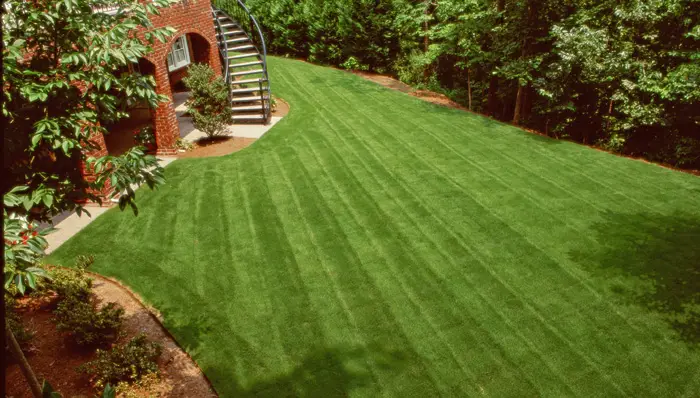If your lawn is in dire condition filled with weeds or just patchy and unhealthy looking then you will want to fix it in the easiest and fastest way possible. However it isn’t just a matter of planting more grass seed on your existing lawn.
Table of Contents
- How To Start A New Lawn From An Old Lawn
- 1. Remove the old lawn and reseed
- 2: Dethatch, aerate & plant grass seed over the dead grass
How To Start A New Lawn From An Old Lawn
There are two different approaches to plant a new lawn over an old lawn.
The first approach involves completely killing the existing lawn and then starting over from scratch.
With the second approach you dethatch, aerate and then seed over the existing lawn.
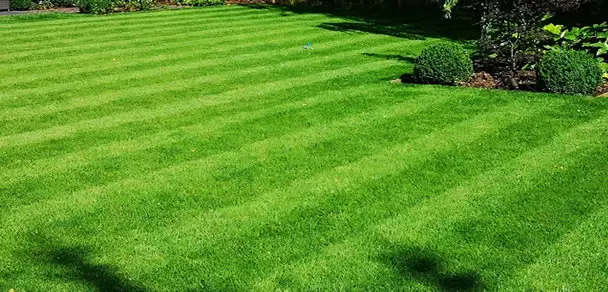 As you can see from the above statements, you have 2 options for starting a new lawn over an existing lawn. Each requires a slightly different approach.
As you can see from the above statements, you have 2 options for starting a new lawn over an existing lawn. Each requires a slightly different approach.
The 2 options for starting a new lawn over an existing lawn:
- Kill the existing lawn and start a new lawn from scratch.
- Prepare the exciting lawn through dethatching and aeration before you sow new grass seed over the dead grass.
The first approach to starting a new lawn when one already exists, will take more time to complete as it involves some preparatory work and requires the killing of the existing lawn.
The second approach is much less time-consuming and is less effort-intensive as you will simply sow new grass seed over the existing lawn (though you must prepare the lawn before doing this).
Let’s take a look at both these approaches to see which one is the best option for you.
1. Remove the old lawn and reseed
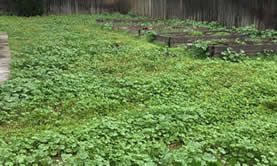 This option is the most time-intensive and effort-intensive approach to creating a new beautiful lawn.
This option is the most time-intensive and effort-intensive approach to creating a new beautiful lawn.
However, it is guaranteed to work.
It is also the best option if your lawn is filled with weeds or moss to a point where they have totally taken over the entire garden.
The 8 steps to start a new lawn from an old lawn
There are five steps you need to follow to start a new lawn from an old lawn.
How To Plant A New Lawn Over An Old Lawn:
- Analyze the soil
- Kill the existing lawn
- Remove the dead lawn
- Till the soil
- Fertilize the soil
- Sow new grass seeds
- Mulch
- Water the seeds
let’s take a closer look at each of these steps in turn.
Analyze your soil
Before you begin doing anything be sure to analyze your soil.
Soil testing services exist that can do this for you.
They will send you a report of your soil with recommendations of which seeds will grow best and steps you can take to improve the lawn.
However, you can use a simple home soil test for about about 20 bucks.
Such a test will give you all the information you need in order to conduct a little research into the best grass to seed for your lawn.
You’ll find out the alkaline and acidic values along with the pH value etc. With that information it is easy to choose a grass seed that grows best in soil with those values.
Why is soil analysis important?
When you know the type of soil that is in your garden you are better prepared for selecting the correct fertilizer for lawn as well as the most appropriate grass and plants.
There are specific grass types that are better suited to specific soil types so choosing the right one for your particular lawn’s soil will ensure you have a healthy vibrant lawn.
Knowing the ph value of your soil can also greatly help you to pick the most appropriate plants, flowers and shrubs if you want to create a garden.
Kill the existing lawn
Although there are chemicals that exist to kill everything in your lawn I do not recommend using them.
Those same chemicals can stay in the soil and seep into your new top layers and attack your new seeds.
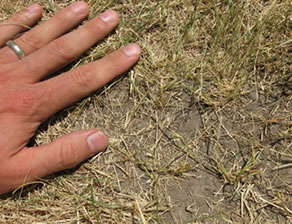 A much better way to kill everything that is growing on your lawn is to do it manually.
A much better way to kill everything that is growing on your lawn is to do it manually.
You can use a sod cutter or simply place black poly film
over the lawn to block out the light.
After 2 + weeks everything growing on the lawn should be dead having fully dried out and turned brown.
All you have to do is lay the poly film over the lawn and secure it with heavy rocks or stake it into the ground.
Check after 2 weeks and if there is still grass/weeds alive leave it for another week.
You will know when the lawn is dead when the grass and weeds have totally dried out and turn brown.
Remove all traces of the old lawn
Once the lawn is completely dead you will need to remove the dead grass and weeds.
Use a rake to clean-up all the dead grass and weeds.
Although you can use a standard tine rake it is a good idea to use a scarifier or thatch rake. A scarifier will make sure you lift up the organic debris by the dead roots and not just the surface leaves or grass.
Till the soil
Before you consider adding top soil or fertilizer to your existing lawn you should till the soil.
When you till the soil you break up all the compacted hard areas making it easier for fertilizers and new soil to mix in with the existing environment.
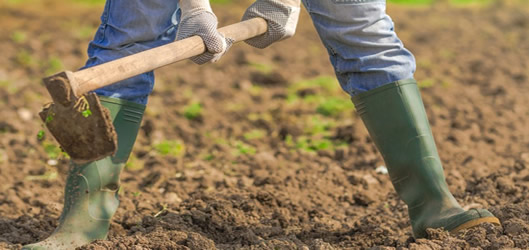
It is also necessary to till the soil to allow room for new seeds to germinate and develop healthy roots.
You can till soil manually with a or use a machine – you can see examples of both types here.
Add fertilizer or new top soil
Now is the time to add fertilizer and/or new nutrient-rich top soil.
Rake in the new soil into a smooth flat plane being sure to manually remove any remaining debris such as rocks or organic matter like dead roots.
Seeds need a level smooth environment in which to germinate effectively so do not skip this step or you will find your seeding efforts produce patchy results when the grass starts to grow.
Plant your seeds
As you have already tested the soil then a simple google search will let you know which grass seed is best suited to that soil type.
When you know which soil type you have then seeding your lawn with the most appropriate grass for your specific soil will give you the best chance of creating a truly healthy and vibrant lawn.
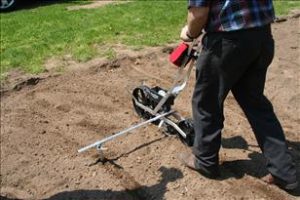 Make sure you use plenty of seed.
Make sure you use plenty of seed.
Many people plant their seeds manually by hand. But using a fairly inexpensive seeder will greatly speed up the entire process, while also ensuring your entire lawn area is covered correctly.
As an optional step you can rake the area after seeding and even cover the lawn with a shallow amount of nutrient-rich top soil.
You can also compact the soil slightly with a sod roller to offer the seeds more protection from the elements and birds which tend to regard grass seed as a tasty treat.
When the grass starts to grow you may want to overseed to fill in any patchy areas that develop.
Mulch
You can, at this time, cover the entire lawn with mulch or a grass seed accelerator. This includes both mulch and the correct mixture and amount of nutrients needed to help new seeds germinate quickly and healthily.
A seed accelerator will absorb more moisture than standard mulch or grass clippings (from a mulching mower for example). It will release it’s moisture and nutrients slowly for steady grass feeding.
An accelerator will also degrade very naturally thus eliminating later cleanup.
Water the seed
Watering is essential to help new seed germinate but be careful not to over-water.
To avoid over-watering many gardeners use a sprinkler system.
The key to good watering is to keep the soil moist but not soaked.
2: Dethatch, aerate & plant grass seed over the dead grass
Option 2 to for planting a new lawn over an existing one requires less time and less effort than option 1, though it does require some physical work on your part in the form of 2 preparatory steps.
The 2 preparatory steps for sowing grass seed over an existing lawn:
- Dethatching
- Aeration
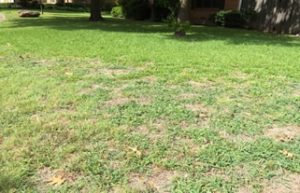 However, if you do it correctly and do not try to take shortcuts it will work just as well as the more effort-intensive option 1.
However, if you do it correctly and do not try to take shortcuts it will work just as well as the more effort-intensive option 1.
This approach is probably your best option if your lawn has limited weeds but has large patchy areas, looks bare and is well-trodden.
The 3 simple steps for sowing grass seed on an existing lawn
There are only three steps you need to follow to start a new lawn over existing dead grass.
How To Plant Grass Seed Over Dead Grass:
- Dethatch the existing lawn
- Aerate the ground
- Sow the new grass seeds over the dead grass
let’s look at each of these steps now.
Dethatching: The first step to planting grass seed over dead grass
Detaching is a great way to remove dead organic debris that has built-up in your lawn over a long period.
Using a scarifying rake or engine powered dethatcher you can easily and quickly remove this dead organic matter.
Why you need to dethatch
Thatch build-up on your lawn occurs when roots and dead organic matter matter (from leaves and dead roots etc), forms a barrier.
This thatch then stops water and nutrients from reaching the roots of grass.
Thatch build-up can form a barrier than is inches thick.
This barrier leads to large patchy areas on your lawn and/or an unhealthy looking lawn that lacks luster and vibrancy. Because water and nutrients can’t pass the thatch barrier to reach the grass roots the grass starves and dehydrates.
When you use a scarifying rake or a dethatcher you pull up this dead organic matter that lies on top of the lawn and that also lies below the top area, thus removing the barrier.
How to dethach your lawn (video)
Aerate: The second step to planting grass seed over dead grass
As well as thatch build-up the soil in your lawn can become very compacted which also stops water and nutrients from reaching the roots of grass.
So dethatching is only the beginning of the process of preparing the lawn for new seed.
After you dethatch you should aerate the lawn to allow water and nutrients to fully reach the roots of existing grass and the seeds you plant when they germinate.
Aeration is the method of breaking up the compacted soil by puncturing ventilation holes in the lawn.
There are a multitude of aeration tools available from hand tools to motorized equipment.
You can also aerate your lawn by hand.
How to aerate your lawn
The best type of aeration tool you need is a hollow tine aerator rather than a solid tine aerator.
There are very specific reason for this which I have already covered in this article.
To summarize: the main reason for using hollow tine over solid tine is that solid tine pushes down the soil down, actually compacting it more at the puncture point. The compacted soil then acts in the same way as thatch – albeit in a much smaller area.
A hollow tine though actually removes a core of the soil thus avoiding this soil compaction problem.
This core can be left on the lawn as it will be broken down by the microorganisms that exist in the soil adding its nutrients back into the lawn.
You can read a more in-depth article on the importance of aeration here.
How to use different aeration tools
You can find a list of different aeration tools here.
Sowing grass seed on existing lawn: How to lay new grass on old grass
Once you have completed the steps above for dethatching and aerating your lawn it is time to add new grass seed.
Yes, it is possible to plant grass seed over dead grass – as long you have dethatched and aerated the lawn before hand.
Overseeding a lawn is incredibly easy. All you do is spread seed across the lawn and allow it to lay there and germinate naturally.
Keep in mind: You can plant grass seed without tilling as long as you have dethatched and aerated the ground before hand.
Sowing new grass over existing grass is often called overseeding or reseeding.
You must ensure there is adequate water coverage before and after seeding if you want your grass to grow evenly.
The best way to make sure the new seed is getting enough water is to use a sprinkler system.
When you overseed your lawn it is a good idea to focus spreading the most amount of seed in areas that are patchy.
However, do make sure you place seed everywhere on the lawn to ensure you have even lawn coverage.

